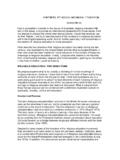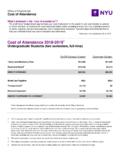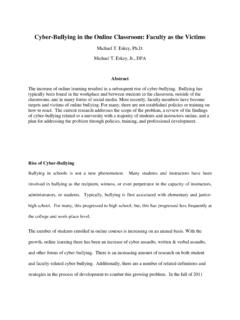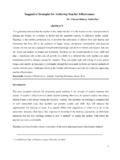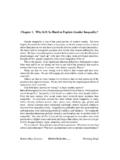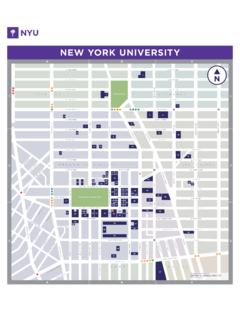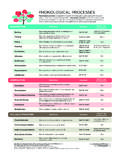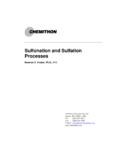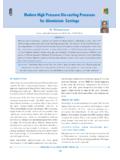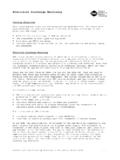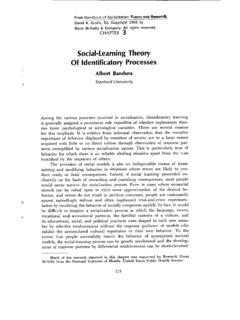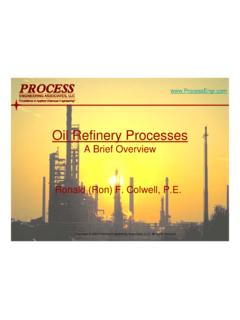Transcription of Requirements Definition and Management Processes
1 11 Software 1 Sub-Topic 1 Requirements Definition & ManagementProcesses and ToolsDr. Jean-Claude FranchittiNew York UniversityComputer Science DepartmentCourant Institute of Mathematical Sciences2 Part IRequirements Definition and Management Processes23 Requirements Best Practices A requirement should be: 9 Unambiguous9 Complete9 Consistent9 Measurable9 Testable9 Traceable9 Design Free9 Understandable9 Concise9 Necessary 9 Feasible/Attainable Documenting Requirements ensures the 9 Stable9 Implementation - independent 9 Traceable4 Requirements Best Practices (cont.) Peer reviews Test each requirement against attribute standards For example: Traceable - Each requirement must be traceable to a businessneed. Baselining Define a clear scope Lock down Establish and enforce change impact analysis and approval process Things to avoid Ambiguous terms ( , easy, user-friendly, etc.) Analysis paralysis35 Enterprise-Wide vs. Project-Specific Enterprise-wide Requirements provide Re-Use Requirements common to a project can be obtained by referring to enterprise-wide Requirements Project-specific Requirements should be evaluated for re-factoring into enterprise-wide requirements6 RequirementsNon-Functional RequirementFunctionalRequirement Interface ConstraintOperational Constraint47 The Big Process Picture Requirements Analysis process fits into other Processes within Integrated Requirements Deliverables output from one process become inputs to other Processes Integrated Requirements provide the glue between the business side and the technology side8 Essential Elements for Requirements Analysis Clarity Efficiency Priority Quality Traceability59 The Elevator Problem(a classic)A product is to be installed to control elevators in a building with 3 floors.
2 The problem concerns the logic required to move elevators between floors according to the following elevator has a set of 3 buttons, one for each floor. These illuminate when pressed and cause the elevator to visit the corresponding floor. The illumination is canceled when the elevator visits the corresponding floor, except the first floor and top floor has two buttons, one to request an up-elevator and one to request a down-elevator. These buttons illuminate when pressed. The illumination is canceled when an elevator visits the floor and then moves in the desired an elevator has no requests, it remains at its current floor with its doors closed. 10 Why Requirements Definition ? Opportunity to improve how Requirements are collected and documented Guide through the establishing of a Baseline Capability Maturity Model Integration (CMMI) initiative Ensure Requirements are complete and correct Establish a change control process Ensure Requirements are traceable611 What is Requirements Management ?
3 Opportunity to determine Impact and control changes to Requirements A systematic approachto eliciting, organizing and documenting the Requirements of the system, and establishing and maintaining agreement between the customer and the project team on the changing of Requirements of the system Most companies rely on a process framework (see samples on next slides) Policies and Standards Processes Procedures Training and Tools Guide through the product lifecycle12 Sample Requirements Definition and Management Framework713 The Requirements Management Workflow What is Requirements Management ? Requirements Management is concerned with: Understanding the goals of the organization and its customers Transformation of these goals into potential functions and constraints applicable to the development and evolution of products and services14 The Requirements Management Workflow (cont.)Analysis/Understand Stakeholders NeedsIncorrect problem analysisCorrect problem analysisDefinethe SystemManage the Scope of the SystemSystem not within scopeSystem within scopeRedefine theSystem DefinitionManagechanging requirementsNew requirements815 Why Manage Requirements ?
4 Requirements need to be managed because: Change is an inevitable part of a project and in fact desirable at times By organizing and tracking your Requirements the team improves it s chances of completing the project: on time within budget meeting client expectations16 Why Manage Requirements ? (cont.) Requirements need to be managed because: Changing Requirements and failure to coordinate these changes to stakeholders is the most common reason for project failures. It ensures that the developed product is in conformance with the Requirements that have been outlined by the customer. It ensures that the product is delivered on time and within Manage Requirements ? (cont.) Managing Requirements helps in establishing and maintaining an agreement between the customer and the project team on the changing Requirements of a for Requirements Analysis Problem vs. SolutionEvolution Abstraction Iteration Modeling Re-Use1019 What is a problem ? In the context of project development, a problem is a gap between what the customer wants and how the project team members perceive the customer s wants.
5 Effective solutions to complex problems requires input from a diverse group of Stakeholders Stakeholdersare people who are affected by the implementation of the system being developed. Analyzing the Problem20 After the problem has been analyzed the system needs to be defined. This involves translating and organizing your understanding of the stakeholders needs into a description of the system to be built. As a result, documents are created that define the product. These are the Requirement Specifications Documents. They include: Use-Case Documents- designed to identify the functional behavior of the system Supplementary Requirements Specification Documents define features of the system in specific terms. Analyzing the Problem (cont.)1121 Part IIRequirements Definition and Management Tools22 What is RequisitePro? IBM Rational RequisitePro (also know as ReqPro ) is an easy-to-use Requirements Management tool It helps teams to: 9 Manage project Requirements clearly9 Organize, prioritize, track, and control changing Requirements of a system or application9 Promote communication and collaboration among team members9 Reduce project risk9 Keep stakeholders informed about the most current Requirements information9 Understand the impact of change which enables team members to manage project efficiently9 Identifying the problem correctly to deliver the right product1223 What is RequisitePro?
6 (cont.) RequisitePro Improves and enhances the software development process. Helps to prioritize Requirements , to trace relationships between them, and mostly importantly track changes that affect them. Captures the change history for each is RequisitePro? (cont.) Successful Requirements Management leads to a quality product: 9that meets customer needs9is completed on time 9is within budget1325 Sample Requirements Documentation Documents may be contained in the set of standard IBM SUMMIT project deliverables: Project Charter System Prospectus Requirements Specification Use Case Requirements Traceability Matrix Requirement information contained in these documents is created and maintained in a project throughout the Requirements Definition Process whether or not the RequisitePro tool is used26 Sample Requirements Documentation (cont.) Requirements Management Plan Included as a section in the Requirements Specification template Identifies how a project manages Requirements listed in the Requirements specification, whether using manual or automated Processes Provides recommendations and guidelines regarding.
7 Requirements Management roles Requirements documents Requirement types and associated attributes Traceability strategy Serves as the configuration document for the IBM RationalRequisiteProtool environment, if elected 1427 Sample Requirements Definition Process Flow28 Sample Support Tools IBM Rational RequisitePro (may be optional) Used as an (optional) Requirements Management tool to support the Requirements Definition (RD) Process Automates the majority of the Requirements Management (RM) Plan Capture and maintain traceability between the various requirement types defined by the RM Plan Enables scope setting, impact analysis, and all aspects of Requirements Management from a project perspective Creates a common repository for all requirement artifacts IBM SUMMIT Ascendant Defines the Requirements Definition and Requirements Management Processes Provides detailed guidance on how to perform the necessary procedures Visual Modeling or Drawing Tool (optional) Enables the creation of a graphical use case representation via a UML-based Use Case diagram 1529 Typical Functions Senior Management Ensure policy, process and procedure adherence Client and Stakeholders Specify, review and approve the Requirements in this document for baseline.
8 Projects using RequisiteProfor storing data will copy a snapshot of the baseline Requirements into this document for review and sing-off purposes Project Manager Plan and manage Requirements documentation activities. Ensure process and procedure adherence and issues resolution Ensure RequisiteProupdates are timely and accurate, if used Business Analyst Document the gathered Requirements in the SUMMIT Requirements specification document, or in RequisitePro, if used. Ensure Requirements meet the criteria for good Requirements and the entire project team understands and agrees with them, Technical Infrastructure Participate in the Requirements documentation activities as appropriate TMO, IBM and DBA roles may be required to access Requirements inRequisiteProfor review purposes, if used Project Support Assist project team with process, templates and training. Enterprise coaches are part of the Project Management Best Practices (PMBP) team30 Typical Roles Senior Management IT Manager, Business Manager, Sr.
9 Leader Client and Stakeholders Approver, Requestor, Stakeholder, End User, Customer Project Manager Project Manager Business Analyst Business Analyst, Lead Business Analyst, Tester, Lead Tester Technical Infrastructure TMO Representative, SMO Representative, IBM Representative, DBS, System Analyst Project Support Project Coach1631 Analyzing & Understanding Stakeholder Needs A stakeholderis someone who has a vested interest in the project/system/contract. Stakeholder needscan be obtained using various methods, such as: interviews questionnaires requirement workshops brainstorming sessions story boards prototypes The result of these interactions can easily be recorded in Rational RequisitePro and/or retrieved from the Project Charter and System Prospectus documents32 Typical Use of RequisitePro Planning/preparation procedure Business Analysts use the Charter and System Prospectus as inputs to create/enter Requirements into RequisitePro Gathering/Elicitation and Document procedures Business Analysts use standard requirement types and attributes defined within RequisitePro to document their Requirements Analyze/Prioritize/Determine Acceptance Criteria procedures Business Analysts use RequisitePro Views Document and Verification procedures Business Analyst use RequisitePro Hierarchical Requirements to best document and verify Requirements Verification procedure Business Analyst use RequisitePro Discussions to conduct peer reviews1733 Typical
10 Use of RequisitePro (cont.) All Procedures RequisitePro relationship traceability and traceability matrices are used throughout the Requirements Definition process Ongoing Review Technical Infrastructure personnel with proper credentials may review RequisitePro data at all times Administration At the end of the Requirements Analysis phase, the RequisitePro administrator applies pre-defined import/export procedures to take a snapshot and create a Requirements specification baseline and attaches it to the System Prospectus in preparation for sign-off by clients and stakeholders The RequisitePro administrator is responsible for configuring RequisitePro security using standard groups and permissions, and synchronizing RequisitePro with TestDirector Project Managers are responsible for timely and accurate RequisitePro updates34 Features of RequisitePro Word-Database Integration Uses Microsoft Word to document Requirements , but complements Word with a commercial database to organize, track and communicate Requirements .
